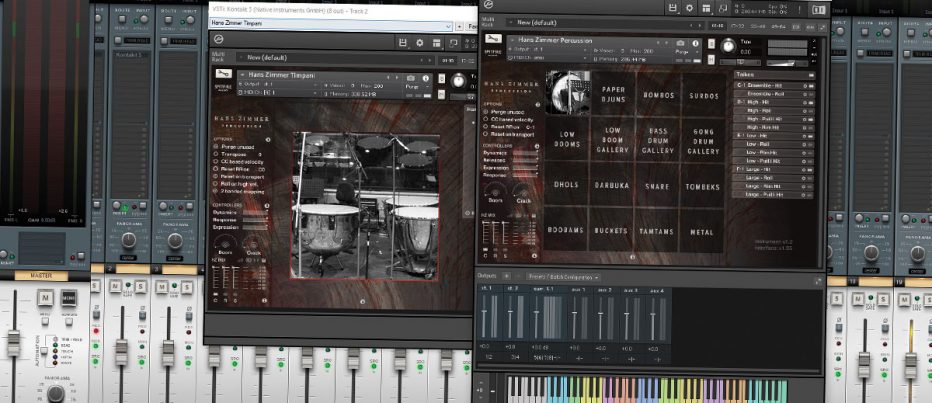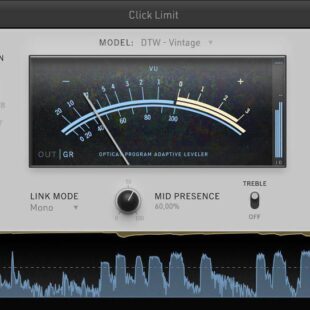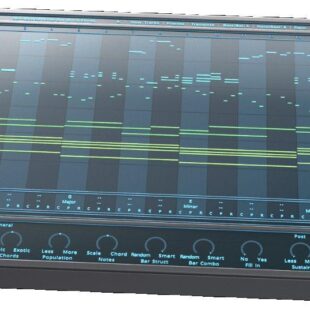Spitfire Audio Hans Zimmer Percussion – Shake Your Foundations
Welcome to Music Nation StudioWise. Spitfire Audio are synonymous with high quality and attention to detail, the latest offering features a fresh new interface and unprecedented access to the production and mixing methods of the master himself, this week we’re looking at the amazing Hans Zimmer Percussion.
For those following the series, Hans Zimmer Percussion libraries have been a prominent part of the Spitfire Audio family for some time, notably the HZ01, 02 and 03 variants. This new collection can be seen as a master bundle as it doesn’t include any newly recorded material, but everything from HZ01 and HZ02 is included with the new ‘Kickstart’ interface, plus, of course, Mr Zimmer has personally mixed and produced this edition. The entire library benefits from not only this but the original wonderful Air Studio environment and the talented team of engineers involved, but 2 years of fine-tuning of the product to get to this stage.
The manual says this is not an emulation, but a recreation, overseen in every detail by Hans himself. Taking on the lead mix engineer, Hans has drawn on his favourite players from decades of recording, including Paul Clarvis (Spectre, The Dark Knight, Harry Potter, Star Wars) for a selection of the solo instruments – this truly is an all-star collaboration of the best in the business.
I’m buzzing to get right into this one.
Overview
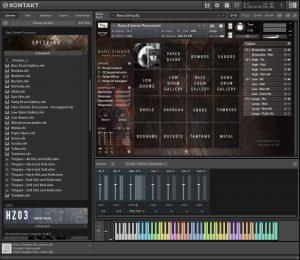 Like all Spitfire Audio products, installation is a breeze. Once you download the core software and registered through Kontakt’s Native Access, you can load it as a playable instrument in your library and you’re away. At 20GB, this is a remarkably frugal download, well…at least for a Spitfire Audio product that is, which has in recent collections surpassed a brow-raising 100GB.
Like all Spitfire Audio products, installation is a breeze. Once you download the core software and registered through Kontakt’s Native Access, you can load it as a playable instrument in your library and you’re away. At 20GB, this is a remarkably frugal download, well…at least for a Spitfire Audio product that is, which has in recent collections surpassed a brow-raising 100GB.
The efficiency is reflected in the DSP requirements as well, most patches hardly tax our systems resources at all, even with the full round-robin and mic options enabled. Interestingly, the entire library only draws slightly more DSP than the factory Kontakt percussion library at full noise. Loading banks is also lightning fast, even on our ageing IDE hard drive system, the largest banks only take 5 or 6 seconds at tops to load. Brilliant.
The biggest visual update to the HZ series is the kickstart Engine UI, a custom-designed interface specifically for percussion. Clearly tailoring to Machine/Akai MPC users and somewhat reminiscent of Reasons Kong, the interface features 16 pads, each featuring a collection of articulations for a drum sample. Each pad features a single instrument but can contain many key articulations for performance, each enabled as required and assignable to custom key locations. There are no built-in effects other than the natural mic ambience, so you’ll need to layer 3rd party plugins for anything unusual like that.
Though not actual clickable performance pads, they can remain static or be set to highlight with an image overlay whenever triggered, which is the way I like to use them. In the main preset bank, each pad has a number of articulations that are not available but not loaded, mostly due to the keyboard being totally full of samples, however, you can easily enable these by selecting and choosing a note on your keyboard, and it’s assigned. Very quick and easy system. There is an unmapped version you can load starting from scratch to make your own keyboard map design, then save it for later use.
Interestingly, the GUI is about 10% wider than our other Kontakt libraries, which is a step in the right direction as I’ve always had an issue with the lack of scaling ability, especially on today’s modern video monitors, our 3440×1440 resolution makes everything tiny. Spitfire Audio has a few other titles using the Kickstart engine (The Grange and Joby Burgess Percussion), but this is the first with the new visual upgrade to the interface, and it looks great.
The Sound
In regards to the sound quality, there’s not much to say other than wow. Of course, this was recorded at one of the best tracking studios in the world, through the incredible Neve 88R console, using 96 rarefied microphones through Neve Montserrat preamps, and recorded through HDX and Prism convertest at 192k resolution. Each articulation includes 9 round robins and 6 dynamic layers per hit – so yes, it sounds incredible.
The way it was recorded gives everything an enveloping, atmospheric sound, even with just the close mics enabled. I found the extra room and surround mic a little too similar and over the top for my taste, but they really do add a wonderful ambience and stereo width if used gently.
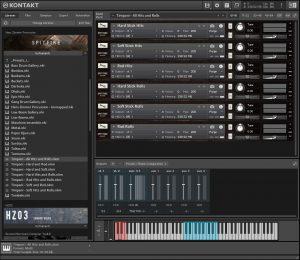
All instruments include a very impressive low-end punch, especially when the response control in pulled right back. Mostly the library sounds better at full noise using heavy velocity, the bombastic instruments demand to be hit hard and fast. Though there is a good level of subtleness achieved by gently feathering the pads, this library is very suited to big trailer scores, loud action sequences and all that Hans Zimmer-style cinematic stuff.
We so happen to have a sizable orchestral arrangement in the studio under production, so it was a great opportunity to put Hans Zimmer Percussion to the test.
The first and most immediate thing I noticed was the entire orchestral sound stage opened up. It’s not so noticeable with percussion sometimes, but it hogs a lot of low-end bandwidth, narrowing your stereo image a lot if you’re not careful. Doing a fairly simple swap out of the samples we were using for similar Hans Zimmer Percussion alternatives (taiko, bass and buckets) right away sounded a lot more organic and detailed. A lot of the low-end trouble I was having with the master mix cleared up, and interestingly my bass and kick drums became a lot more present in the mix.
Also, a happy side effect is the CPU demands dropped noticeably too, as we were using 3 instances of Kontakt previously, and now we just have the single Kickstart instance.
Playstyle
All the innovative wizardry in the world is pointless if you can’t play the instrument proficiently.
Using just the default preset, the full range of percussion instruments on hand is impressive. While the playability, for the most part, is great, the expression controls to the left of the screen are fundamental for the best authenticity. By default, they are set as global controls, dynamics, tail release, volume expression and response – but you can assign individual controls to each pad if you desire.
The expression controls are simple and you’ll be mostly using the dynamics on CC1, and possibly the release on rolls. The response control is the one you want to become masterly at, it increases the quietest level up to match the loudest – sort of like a compressor, but using MIDI velocity. The results are incredible, even the softest of touches result in earth-shattering bass. It’s an odd phenomenon at first, but you start to learn the best instruments for applying this control over time. With this one slider, you can change the entire output from mild-mannered to speaker-blowing epicness.
Despite the fact that I’m no place close to what you’d call an accomplished orchestral percussionist, I feel my performances are enhanced by the software. There is an immediate almost tactile feedback to the sounds when you’re playing at volume. Of course, nothing is coming back through the keyboard to your fingers, but it’s the percussive sound waves from your monitors that give you the sensation of actually striking the drum. It’s an immersive sensation once you get into the groove and absolutely helps a hamfisted basher like me put together some rather convincing lines.
The MPC pad arrangement works very well with my Akai MPD218 controller too, which is my preferred option for performance. You can get a much finer touch with the pads over a weighted piano like our MOTIF. Included is a Native Instruments Maschine-specific patch, but I personally found scratching and building my own custom bank easy and worked better with my hand muscle memory to place certain instruments under certain fingers.
Conclusion
An extraordinary collaboration from the best in the business from all aspects of the development team, from the studio floor playing the raw instrument sounds, the engineers, studio, software developers and of course Mr Zimmer’s stylistic and pure cinematic mixing style.
Though capable of huge of sound-type hits, the real surprise for me is the clarity and width it brings my arrangements, mostly due to the clever mixing and micing. I do have an unfortunate desire now to totally overplay the percussion at any opportunity in my arrangement, but that’s a happy personal issue I will work on over time.
If I had to criticise, it would be aimed at the collections rather aggressively and in your face style, after all, it is a Hans Zimmer drum library I guess. I would have liked to have seen a few more embellishments like an anvil, chimes and triangle, and maybe a few softer mallets and possibly some FX. Also, I do greatly miss Spitfire Audio’s excellent Ostinatum groove player present in the other libraries too, something that I think would have really worked well for percussion.
Once more, a masterpiece from Spitfire Audio and another required purchase for digital composers. I am genuinely sorry, but your credit card will just have to grumble and bear the cost of this library, as there is quite simply nothing even close out there for variety, detail and sound quality
Full details and purchasing options can be found on Spitfire Audio’s website here www.spitfireaudio.com

